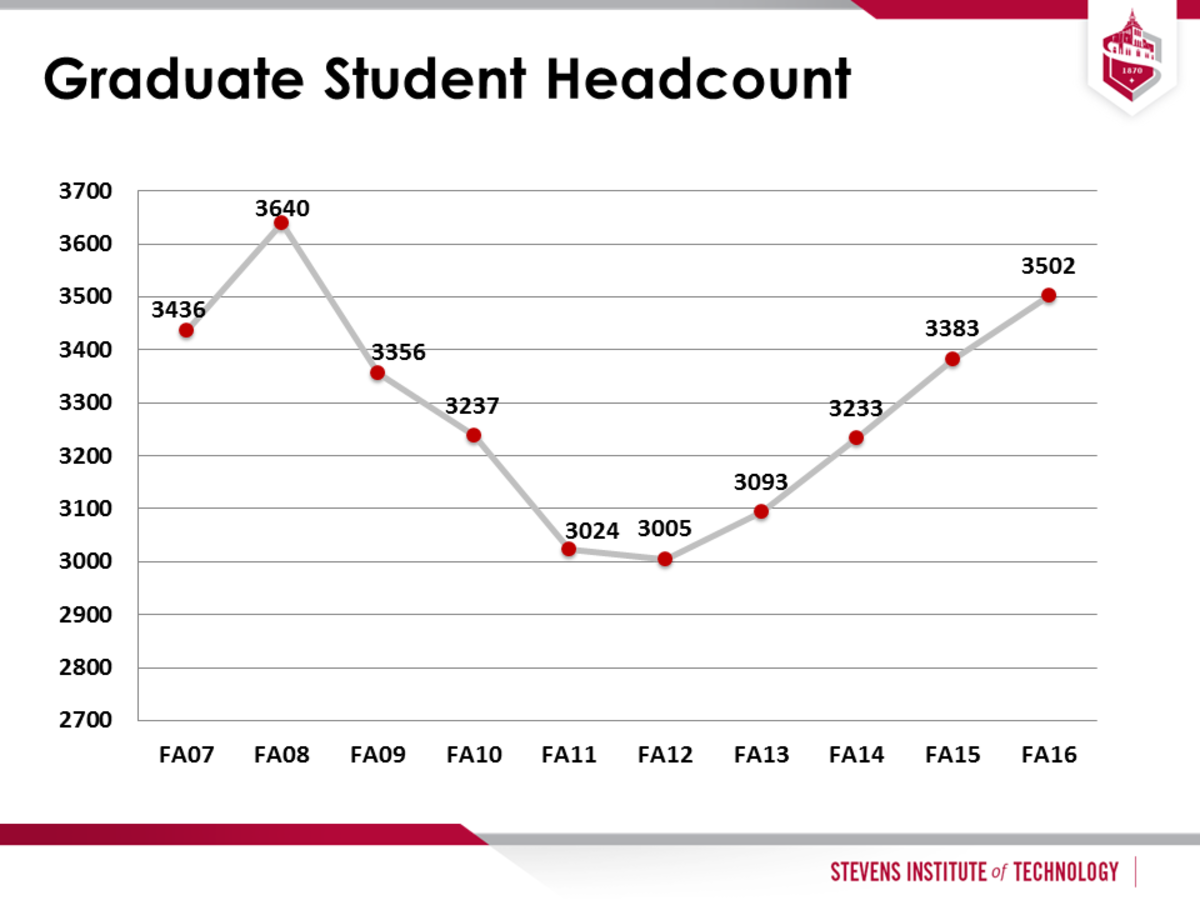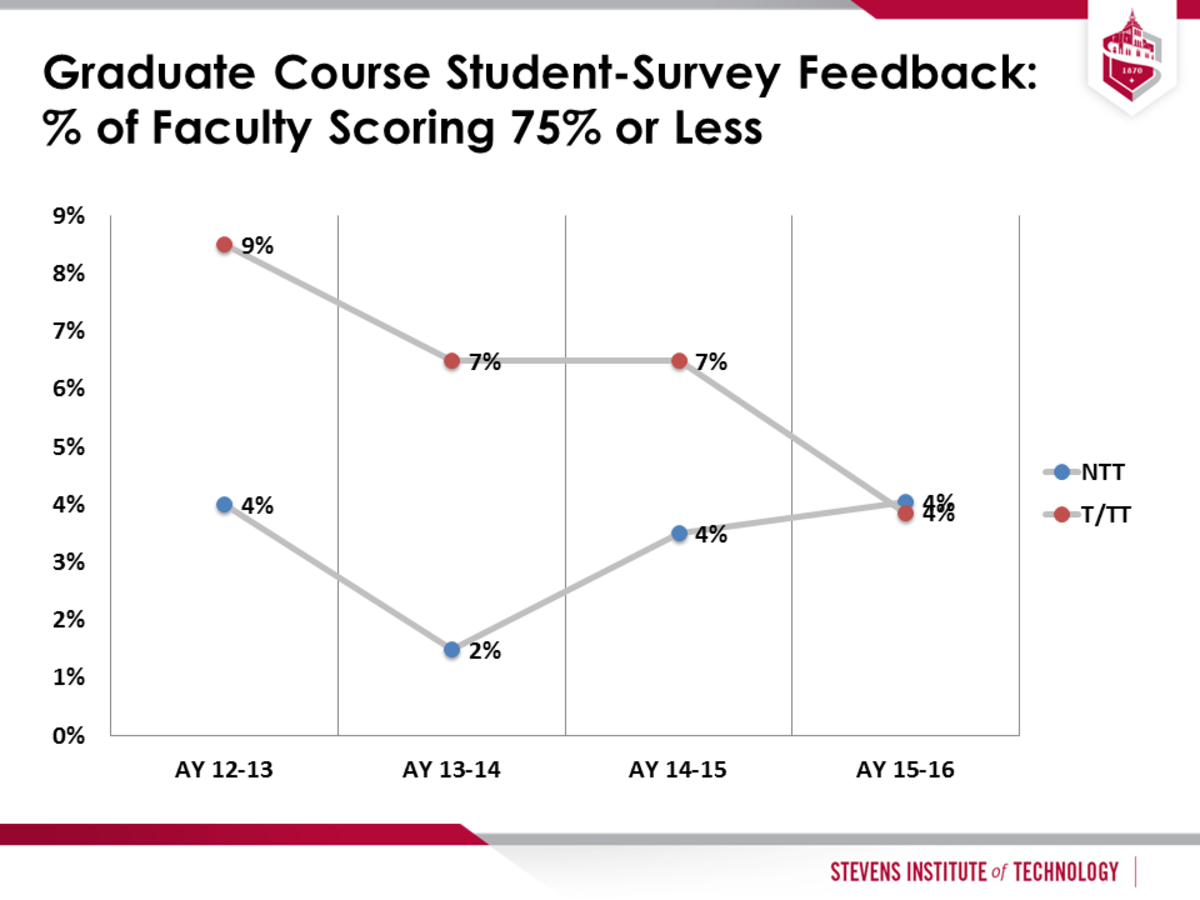Graduate student applications increased by 37 percent; the cohort of new graduate students increased 23 percent; and full-time graduate enrollment increased 8 percent over Fall 2015. Selectivity increased by one percentage point. A number of initiatives to integrate graduate students into campus life are having an impact.
Goal G1 (Revised)
Improve the selectivity of graduate admissions from 74.2 percent in 2011 by admitting only 56 percent of applicants by 2017 and only 42 percent by 2022. Increase the number of full-time Ph.D. and master's degree students from 1,248 in Fall 2011 by 30 percent through 2022.
OWNER: PROVOST GEORGE KORFIATIS (YEAR 4) PROVOST CHRISTOPHE PIERRE (YEAR 5)
The number of graduate applications increased by 37 percent: 7,688 in Fall 2016 vs. 5,623 in Fall 2015, and the selectivity ratio (percentage of total applicants offered admission) improved by one percentage point in 2016: 57 percent in 2016 vs. 58 percent in 2015. The cohort of new graduate students increased from 1,086 in Fall 2015 to 1,324 in Fall 2016.
The overall headcount of graduate students increased 4 percent from Fall 2015 (3,383) to Fall 2016 (3,502). Full-time graduate students increased 8 percent from Fall 2015 (2,137) to Fall 2016 (2,301) and 84 percent from Fall 2011 (1,248), while part-time students decreased 4 percent in one year (1,246 in Fall 2015 vs. 1,201 in Fall 2016) and 36 percent since Fall 11 (1,866), in line with plans to increase the proportion of full-time graduate students.
The number of countries represented by enrolled new international graduate students in Fall 2016 was 25, compared to 24 for Fall 2015, with the majority of new students coming from two countries. Domestic students accounted for 32 percent of the Fall 2016 cohort of new graduate students, as compared to 43 percent for Fall 2015.
Year 5: A 1-2 percent increase in total graduate credit hours compared to FY16 with emphasis on improvement in selectivity, academic profile, and geographical diversity is planned. Attractive financial aid packages for highly qualified incoming students, especially at the doctoral level, will be developed to reduce reliance on students from one or two countries. Key indicators of the performance of the graduate admission process (number of applications, selectivity, academic profile of admitted students, diversity of admitted students including number of domestic students, number of newly enrolled students by discipline, etc.) will be developed in collaboration with the Office of the Provost against which annual admission targets will be established. The variations between growth in new graduate students and overall graduate enrollment will be analyzed to develop a plan to ensure appropriate retention of graduate students.
1.The Fall 2015 new graduate student enrollment was corrected from 1, 210 to 1, 086.
Goal G2 (Revised)
Increase the number of domestic and international corporate graduate partnerships by 3 per year over Fall 2011 (36 including 3 international) and increase the number of corporate students by 5 percent per year (YoY) through 2022.
OWNER: PROVOST GEORGE KORFIATIS (YEAR 4) PROVOST CHRISTOPHE PIERRE (YEAR 5)
The number of domestic and international corporate graduate partnerships as of Fall 2016 is 39, compared to 40 in 2015, an 8 percent increase over Fall 2011.The number of corporate (traditional semester and Y-Term) students held relatively steady from AY 2014-15 (1,491) to AY 2015-16 (1,500).
Year 5: Incorporate all professional education activity (online, corporate cohorts, agreements, professional development, non-credit, and interdisciplinary programs) into a coherent office of continuing and professional education. Review budgets and maximize our resources and procedures for offering continuing and professional education programs. Planning, resources review, and implementation for an office of continuing and professional education will be completed by June 30, 2017.
Goal G3
Undertake specific initiatives to improve our graduate faculty teaching performance and student learning.
OWNER: PROVOST GEORGE KORFIATIS (YEAR 4) PROVOST CHRISTOPHE PIERRE (YEAR 5)
The assessment of teaching performance processes initiated in Year 3 continued in Year 4, based on student course evaluations. For Year 4, 4 percent of T/TT faculty scored 75 percent or below on teaching evaluations in AY15-16 (vs. 7 percent in AY14-15). For NTT faculty, 4 percent scored 75 percent or below on teaching evaluations in AY15-16, the same percentage as the prior year.
Year 5: Continue efforts launched in Year 3 and refined in Year 4; measure the impact and refine activities based on data.
Goal G4
Develop and formalize mechanisms to ensure all graduate students, including part-time and off-campus students, have opportunities to engage with the Stevens community as part of their curricular studies, as well as through extra-curricular activities.
OWNER: PROVOST GEORGE KORFIATIS (YEAR 4) PROVOST CHRISTOPHE PIERRE (YEAR 5)
Initiatives assessed for participation and/or impact during AY 2015-16 included the graduate student enrichment series (46 sessions, 1,000+ attendees, which was a 17 percent increase from previous year); graduate conference funding (34 participants, a 50 percent decrease); airport pick-ups (440 student pick-ups); temporary housing provided (618 night stays provided to 113 students); Green Line student shuttle service (with a daily ridership of approximately 400+ students) and a host of social engagement activities and events (2,000+ participants).
New initiatives launched this past year include the “Teaching at the College Level” program for Ph.D. students (23 students received a certificate of completion); the Professional Pathways program (more than 290 international students participated); and the Graduate Women’s program, which was launched to address specific needs of women graduate students (117 students participated in a series of events).
Year 5: Continue to monitor and evaluate for participation and impact, refine existing programs, add new as needed, increase participation and resources.

